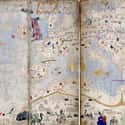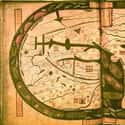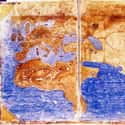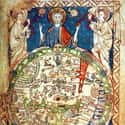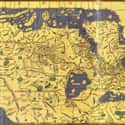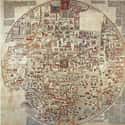-
(#11) Catalan Atlas, 1375
In the late 1300s, the most famous mapmakers in Europe were a family of Catalonian Jews. King Charles V of France commissioned the Catalan Atlas to show the most current geographical knowledge in the world, as of 1375. The map is an artistic creation that combines portolan chart geographic knowledge with hundreds of illustrations.
On the world map, you can spot Europeans traveling the Silk Road to China; a warrior elephant with sharpened tusks; the flags of various territories; and strange birds, animals, and people. The map also paints many of the islands, such as Corsica and Sardinia, in gold. Islands were a popular topic of fascination in the late medieval and Renaissance period, and multiple mapmakers created “Isolarios,” or books of islands, that would simply contain maps of different islands. On sea charts, islands were an obstacle to navigation, but they were also linked to the notion of a territorial state.
-
(#7) Beatus Map, Circa 776
There are multiple versions of the so-called Beatus map, originally included in an 8th-century Commentary on the Apocalypse by Beatus of Liébana. Like the Psalter Map, versions of the Beatus map were included in religious texts in order to illuminate the study of religion.
The Earthly Paradise is shown at the top of the map, with Adam, Eve, and the serpent all making an appearance. But the map also includes fascinating decorative elements. The waters of the world are filled with fish and boats, and palaces also dot the land.
-
(#12) Medici-Laurentian Atlas, 1351
Some medieval maps are still recognizable today. Africa might appear a bit strange on the Medici-Laurentian Atlas map from 1351, but Europe, North Africa, and the Middle East are all remarkably accurate. That’s because the anonymous maker of this map, probably from Genoa, was trained in making portolan charts.
Portolan charts were used by sailors to navigate the Mediterranean and Black Seas. They required precise geographic knowledge so ships would not get lost. While this expensive and beautifully painted map would not have been taken out to sea, it incorporates knowledge from portolan charts. It also serves as a reminder that religious medieval maps were not produced because mapmakers lacked geographical knowledge, but because the maps served a specific purpose.
-
(#2) Psalter World Map, Circa 1265
Just in case the religious nature of the map isn’t clear, the Psalter Map, made in the 1260s, drives the point home by placing a giant image of Jesus on top. This small map, measuring only 6.6 inches high, was painted in a 13th-century copy of the Book of Psalms. In addition to Jesus holding court over the world, the Psalter Map places a large bull's-eye over Jerusalem at the center.
Mythical monstrous people inhabit the right side of the map, while the Red Sea is actually painted red. But these monsters are not just figments of the unknown mapmaker’s imagination: they are based on classical texts like Pliny the Elder’s Natural History. Pliny claimed a North African tribe was “said to have no heads, their mouths and eyes being seated in the breasts.” Here, Pliny’s classical tales mix with biblical knowledge on one map.
-
(#10) Tabula Rogeriana, Circa 1154
This map is perhaps the most worldly. The Tabula Rogeriana - Latin for the Book of Roger - was created around 1154 by a Muslim scholar named Al-Idrisi. He was born in North Africa, educated in Islamic Spain, traveled across the known world, and eventually worked for Roger II, the Christian king of Sicily. In the 12th century, Sicily was heavily influenced by Byzantine, Catholic, Muslim, and Viking traditions. The Normans, former Vikings who settled in France, conquered the island’s Arab rulers and claimed it for themselves. Greeks, Romans, Byzantines, Arabs, and Normans had all claimed Sicily.
So it's no surprise that Al-Idrisi created one of the most accurate, complete maps of the known world. Al-Idrisi drew on interviews with dozens of travelers, in addition to authoritative texts.
However, the Tabula Rogeriana is also a product of its time, and the best reminder is the fact that the map places south at the top. For Al-Idrisi, the world he knew best - the Muslim territories of North Africa - was to the south, so it made sense to place it at the top.
-
(#9) Ebstorf Map, Circa 1234
The king of medieval religious maps is the Ebstorf Map, made in the 1230s. It was rediscovered 600 years later, in the 19th century, in a convent in Ebstorf, a small town in Germany. The map takes the typical T-O format, with Asia at the top and Europe and Africa below. It is also the largest known medieval map, measuring nearly 12 feet across. It is so enormous that the map was drawn on 30 goatskins.
The most startling feature of the map, besides its size, is the curious image at the top, sides, and bottom of the map. Look closely, and you’ll spot hands and feet sticking out of the Earth, and a head perched at the top of the map. The figure is Jesus; the world, according to the unknown mapmaker, is literally the body of Christ.
The time, money, and effort that went into creating this medieval map were all erased in 1943 during a WWII air raid on Hanover, when the original map met its end.
New Random Displays Display All By Ranking
About This Tool
In the Middle Ages, people did not have map consciousness. As a new civilized world is being formed, the concept of maps that once existed in the Greco-Roman era is gradually dying out. Although some ancient Roman world maps were preserved until the early Middle Ages, they apparently disappeared as slowly as the dying classical traditions and knowledge, which also led to the production of strange maps at that time.
The knowledge and techniques of scientific mapping were not rediscovered until the 15th and 16th centuries. The random tool shows 12 weird maps of the Middle Ages that you must be interested in.
Our data comes from Ranker, If you want to participate in the ranking of items displayed on this page, please click here.











